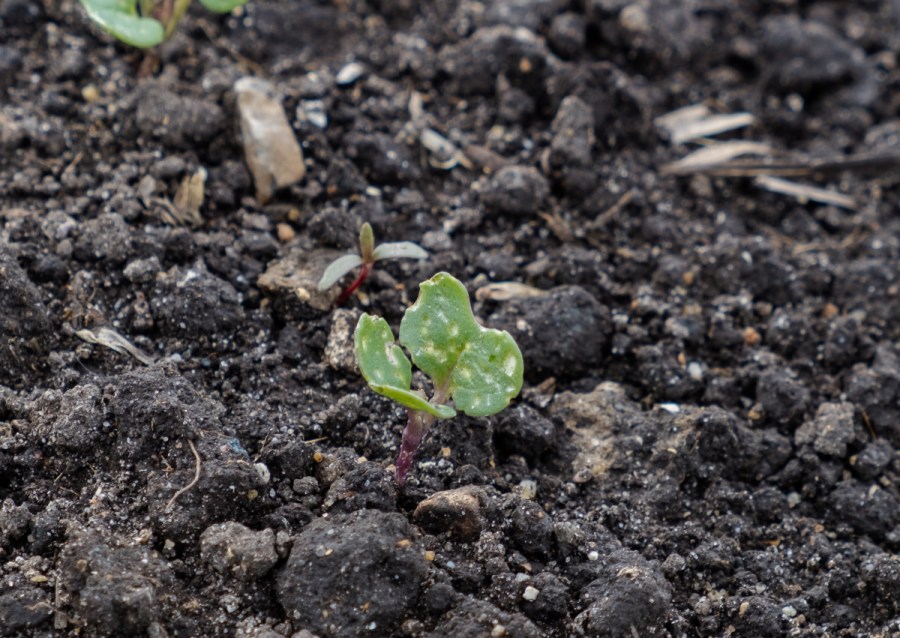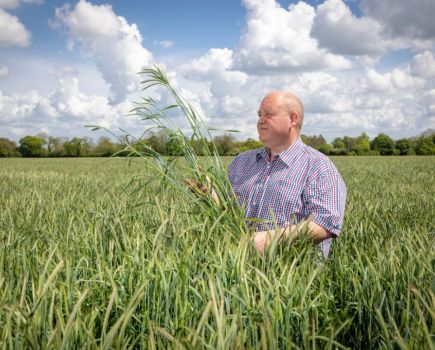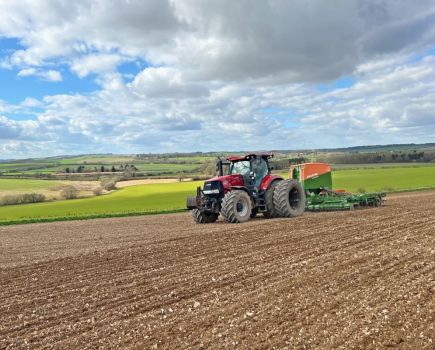Farmers are ditching insecticides in favour of more integrated approached to control the damage caused by cabbage stem flea beetle, that’s one of the key findings in the second national study of CSFB management carried out by Bayer this spring. CPM digs deeper.
While 42% of growers continued to apply insecticides, this was much lower than the 67% doing so in 2019.
By Lucy de la Pasture
As well as providing valuable feedback to growers ahead of this autumn’s plantings, the intelligence from the national study will form part of current ADAS-led AHDB research and NIAB-led csfbSmart projects (reported in CPM’s Theory to Field, April 2021) which aim to reduce the impact of CSFB across the country.
The study confirms that oilseed rape crops this season are in a far more promising position than last, which as the price of rapeseed soars to unprecedented levels is widely hoped may help precipitate a renewed interest in the crop.
“With the heartening extent by which the national crop position has improved this season, we expect to see a marked improvement in harvest performance. This and crop values of over £500/t with oil bonuses are a just reward for those who have continued to stick with OSR and the extra management efforts they have had to put in,” comments Bayer study co-ordinator, Lizzie Carr-Archer.
The study reports that for the c15,000ha of OSR planted last autumn, the average re-drilling rate was just 5% compared with 14% identified in the study undertaken at the same time in 2020. The crop’s chances in 2021 continued to look up as 91% survived through to the spring, with 89% of crops being taken through to harvest, compared with 67% and 60% respectively in 2020.
“This much improved position results from a combination of noticeably lower autumn CSFB pressure and much better soil moisture conditions at drilling,” observes Lizzie.
“Less than 20% of crops were reported to have suffered an intense or substantial challenge from CSFB last autumn, with over 80% seeing a moderate or lower challenge. This is in marked contrast to 2019, when over half the crops faced a particular challenge from the pest.
“At the same time, only around 15% of this season’s crops had to deal with fairly or very low soil moisture conditions at establishment compared with nearly 40% last season.”
Once again, the study reveals levels of CSFB pressure vary widely across the country – with the North, Scotland and East Midlands experiencing noticeably less of a challenge than other regions. In all areas, pest pressures were reported to be much lower than the previous season.
Soil moisture at establishment was also much better than in 2019/20 in all regions, with more than 80% of crops having good or reasonable levels in every case.
Reflecting its continued advantage in terms of CSFB pressure, the North and Scotland experienced the least level of re-drilling and highest proportions of plantings which survived through to the spring and were taken to harvest.
The greatest year-on-year improvement was evident in the East Midlands – perhaps due to a reduced pest carryover with so few crops surviving last season and much lower plantings this time around. Here, 95% of plantings are being taken through to harvest compared with just over 40% last season.
Although much better than in 2019/20; the South, West Midlands and Wales fared worst – with only 84% of plantings being taken through to harvest in 2021.
“Unfortunately, some growers in some regions have again suffered more than most, and the wet winter and late, cold spring didn’t help crops that were struggling,” notes Lizzie. “But serious losses appear to have been far more localised than previously, and even where they have carried significant larval burdens, many crops have been sufficiently well-established and vigorous enough to deal with them.
“This is underlined by an average crop larval recovery rating of 7.5 on a 0-10 scale (from crop written off to no impact on normal crop growth and development) in this season’s study compared with 5.0 in 2020,” she explains.
Part of the success of the OSR crop may be due to earlier drilling, reveals the survey. Approaching two hundred growers took part in the study and of the 250-plus crops involved, nearly half were drilled before 20 August, compared with less than a third in 2019. Far fewer crops were planted in the traditional mid-late August slot. What’s more, the study suggests this trend is set to continue, with almost four in every 10 growers planning to drill very early this autumn.
“For the second year running, overall crop performance declined with a delay in drilling. A far less challenging establishment season meant the differences in crop survival to harvest were less marked than in 2019/20. However, the trend was remarkably similar, with performance from September sowing suffering under a period of relatively higher pest pressure and lower moisture levels,” says Lizzie.
“The relatively poor performance of September drillings was mirrored in the establishment scores given by growers for their various crops. An average score of 6.8 here (on a 0-10 scale from crops lost to perfect establishment) contrasted with scores of 8.0 or more for all earlier sowings.
“Once again, our study recorded higher levels of CSFB larvae from earlier drilling wherever there was a particular autumn challenge from the pest,” she points out. “Among other agronomic consequences, this is something those moving drilling forward should be especially aware of when it comes to their management,” she says.
“Providing there’s enough moisture in the ground and you preserve it well, early drilling can clearly be a valuable defence against CSFB. But only if you use a variety well-suited to the slot; resist the temptation to push-up seed rates; and do everything possible to minimise the appeal of crops to migrating flea beetles. Otherwise, you could easily create more problems than you solve.”
Of the 17 main techniques being employed to manage the CSFB threat at establishment, four stood out as the most successful in the study. As well as sowing earlier than normal; employing seedbed fertilisers, using vigorous fast-developing hybrids and spreading organic manures were all rated at 6.3 or more on a 0-10 scale of effectiveness by the growers involved.
Also rated above 6.0 were minimising tillage and double rolling, while leaving OSR volunteers from previous crops and spraying with insecticides were scored the lowest. Instead, encouraging natural enemies by avoiding insecticides was considered noticeably more effective than spraying with insecticides by growers (with an average score of 5.9).
Techniques to encourage natural enemies by avoiding spraying or promoting natural predator habitats were also rated as more effective than insecticides to manage CSFB larvae. But using varieties with faster or earlier spring development was rated the most effective method to deal with a larval burden.
“With an average effectiveness score of 5.9 on the 0-9 scale compared with 3.9 in 2019/20, growers clearly rated the techniques they employed to manage adult CSFB as more effective this season,” comments Bayer commercial technical manager, James Howat. “A natural observation given the much better overall crop performance seen this season.
“While 42% of growers continued to apply insecticides last autumn, this was much lower than the 67% doing so in 2019, with far more growers than the previous season employing only one or two sprays rather than three or more.
“This change may owe more to the lower observed CSFB pressure last autumn than anything else is suggested by the fact that insecticides were still being used by almost two thirds of growers with the best performing crops under significant autumn CSFB pressure,” he adds.
“The positive association between better performance in the face of CSFB and the use of vigorous fast-developing hybrids and seedbed fertilisers is obvious too, as is the negative association with higher seed rates,” he notes.
Other management techniques being looked at include leaving long cereal stubbles, organic manuring, OSR volunteer trap crops and companion cropping and interest in these is markedly higher than last autumn, according to the study. In contrast, the use of higher seed rates is being planned by noticeably fewer growers than this time last year.
Can companions lend a hand?
One of the techniques being experimented with to mitigate the effects of adult CSFB is companion cropping. Speaking recently at the AgriFood Charities Partnership (AFCP) forum, agro-ecologist Dr Gaëtan Seimandi-Corda presented the results of research being carried out at Rothamsted Research as part of the EU-funded Ecostack project.
“One of the options that could be useful to farmers is companion cropping – growing different crops simultaneously in the field. This has been shown to be beneficial for ecosystem services, such as weed suppression, biodiversity, soil quality and disease control.
“Plant diversity reduces herbivory pressure and companions have also been shown to achieve this in several ways, including disturbing the pest’s ability to locate the host plant by ‘hiding’ the crop, attracting the pests outside of the crop or by repelling insects. It can also have a positive effect on natural predators,” he explains.
UK farmers have been trying different species over the past few seasons, including berseem clover, buckwheat, linseed, fenugreek, vetch and cereal volunteers. “The practice has come from other countries where frost-sensitive legumes are commonly used as companion crops. But the problem with this approach in the UK is mild winters, so the research at Rothamsted aims to identify companion plants for OSR which are adapted to the conditions in the UK and then collect robust evidence on their effect on CSFB.”
Over the past three years, field trials at Rothamsted have been looking at different options, including white mustard, berseem clover, turnip rape, vetch, straw mulch (to simulate direct drilling into stubble) and different cereal species.
Researchers measured adult feeding on the leaves as well as plant density (plant/50cm2) and larval infestation. Significant reduction in CSFB attack was found with white mustard and wheat as companions, but an effect from berseem clover wasn’t established, possibly because its establishment was poor in the trial, explains Gaëtan.
“Where a straw mulch was used to simulate direct drilling, it reduced CSFB attack and maintained moisture in what proved to be a very dry season, so plants were able to compensate for CSFB attacks.”
Cereal species as companions were looked at more closely and showed they can reduce attacks in some conditions, but the only significant reduction in the trial was from using a straw mulch. In further work the trial was refined further, with oats chosen as the cereal companion because of its lower seed cost and ease of removal with herbicides but the crop failed in the UK. However sister trials in Germany saw a clear reduction in CSFB where oat companions were used and an even bigger effect where a mulch was used, which confirmed the initial results at Rothamsted.
Berseem clover also reduced CSFB attacks as companions but at a different timing to the oats. The oats had a significant effect early in the season whereas the berseem clover was later, which reflects that the clover takes more time to develop, explains Gaëtan.
Further research looked at the relationship between the biomass of the companion crops and CSFB attack and found the higher the density of the clover, the lower the CSFB damage. However this relationship was not true where oats were used as the companion (at a higher seed rate). The higher the density of berseem clover, the bigger the OSR plant but the opposite applied with oats, indicating competition with the crop.
“Where cereal volunteers or oats are used as a companion it can be a good option, but they need to be destroyed rapidly to avoid becoming competitive with the crop. Berseem clover tends to reduce CSFB feeding but grows more slowly than cereals.
“Larval infestation also tends to reduce with companion plants, but this does not always hold true. Berseem clover as a companion plant can make the OSR plant bigger and these larger plants can be more suitable for larvae and are also preferred for egg-laying,” he adds.




